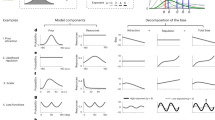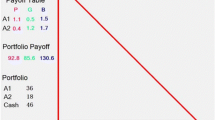Abstract
The Biased Choice Model is often used in psychology to analyze asymmetric confusion matrices arising from stimulus identification experiments. In this paper, several mathematical properties of the Biased Choice Model as well as the conditions under which the Biased Choice Model completely fits a data matrix are investigated. Then a new parameter estimation procedure is proposed and an interpretation of the Biased Choice Model in terms of maximum entropy principle is presented.
There are many sub-models that impose further structure on the Biased Choice Model. This paper clarifies the relationships among such models and the conditions under which these models fit the data.
Similar content being viewed by others
References
Bartholomew, D.J. (1987) Latent variable models and factor analysis. London, U.K: Carles Griffin, & Company.
Bishop, Y.M.M., Fienberg, S.E., & Holland, P.W. (1975) Discrete multivariate analysis: Theory and practice, Cambridge: MIT Press.
DeSarbo, W.S., Johnson, M.D., Manrai, A.K., Manrai, L.A., & Edwards, E.A, (1992) TSCALE: A new multidimensional scaling procedure based on Tversky’s contrast model. Psychometrika, 57, 43–69.
Holman, E.W. (1979) Monotonic models for asymmetric proximities. Journal of Mathematical Psychology, 20, 1–15
Kapur, IN. (1989) Maximum-Entropy Models in Science and Engineering. New York: Wiley.
Keren, G. & Baggen, S. (1981) Recognition models of alphanumeric characters. Perception & Psychophysics, 29, 234–246.
Luce, R.D. (1959) Individual Choice Behavior. New York: Wiley.
Luce, R.D. (1963) Detection and recognition. In R.D. Luce, R.R. Bush, & E. Galanter (Eds.), Handbook of Mathematical Psychology (Vol 1). New York: Wiley.
Nosofsky, R. (1985) Overall similarity and the identification of separable-dimension stimuli: A choice model analysis. Perception & PsychOPhysics, 38, 415–432.
Nosofsky, R. (1991) Stimulus bias, asymmetric similarity, and classification. Cognitive Psychology, 23, 94–140.
Oden, G.C. (1979) A fuzzy logical model of letter identification. Journal of Experimental Psychology: Human Perception and Performance, 5, 336–352.
Shepard, R.N. (1957) Stimulus and response generalization: A stochastic model relating generalization to distance in psychological space. Psychometrika, 22, 325–345.
Shepard, R.N. (1958) Stimulus and response generalization: deduction of the generalization gradient from a trace model. Psychological Review, 65, 242–256.
Shiina, K. (1988) A fuzzy-set-theoretic feature model and its application to asymmetric similarity data analysis. Japanese Psychological Research, 30, 95–104.
Smith, J.E.K. (1982) Recognition models evaluated: A commentary on Keren and Baggen. Perception & Psychophysics, 31, 183–189.
Smith, lE.K. (1992) Alternative biased choice model. Mathematical Social Sciences, 23, 199–219.
Takane, Y., & Shibayama, T. (1986) Comparison of models for stimulus recognition data. In I de Leeuw. W. Heiser, J. Meulman, & F. Critchley (Eds.) Multidimensional data analysis. Leiden, Netherlands: DSWO Press.
Takane, Y., & Shibayama, T. (1992) Structures in stimulus identification data. In F.G. Ashby (Ed.), Multidimensional models of perception and cognition, (pp.335-362), Hillsdale, NJ: Erlbaum.
Townsend, J.T., & Landon, D.E. (1982) An experimental and theoretical investigation of the constant-ratio rule and other models of visual letter confusion. Journal of Mathematical Psychology, 25, 119–162.
Tversky, A. (1977) Features of similarity. Psychological Review, 84, 327–352.
Wilson, A.G. (1967) A statistical theory of spatial distribution models. Transportation Research, 1, 253–269.
Zadeh, L.A. (1965) Fuzzy Sets. Information and Control, 8, 338–353.
Author information
Authors and Affiliations
About this article
Cite this article
Shiina, K. Mathematical Properties of the Biased Choice and Related Models. Behaviormetrika 25, 45–64 (1998). https://doi.org/10.2333/bhmk.25.45
Received:
Revised:
Published:
Issue Date:
DOI: https://doi.org/10.2333/bhmk.25.45




